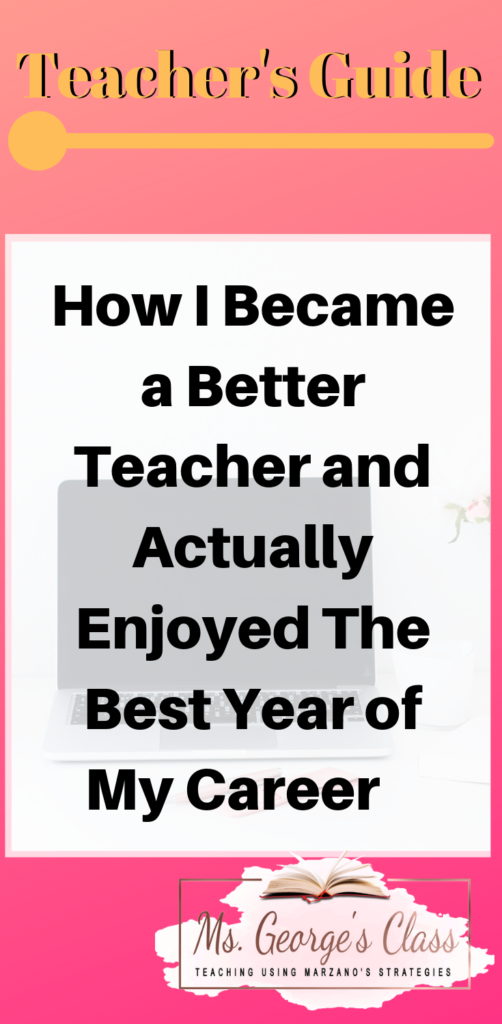
Wow! This school year has really been a good year! I feel more confident at my new school, my classroom management has been effective, and I am less overwhelmed with work. This is probably my best teaching year. My attitude is so much more positive, and I feel even more passionate about teaching. What has changed? I have to contribute much of my joy in producing this blog and the group of students I teach. For the first time in years, I am not looking forward to summer break, and that is a great thing.
Reading Teacher Books
I began this school year reading books, specifically Robert Marzano’s books, to help improve my teaching. I read The New Art and Science of Teaching and Classroom Management That Works by Robert Marzano. I also read How to Differentiate Instruction in Mixed-Ability Classrooms by Carol Ann Tomlinson, Becoming a Better Teacher: Eight Innovations that Work by Giselle O. Martin-Kniep, and Standards for Ohio Educators. I’m currently in the middle of reading Teaching Like a Champion 2.0 by Doug Lemov and The Academic Writing Assignments: Designing the User’s Journey by Jim Burke. I had most of these books for years, and because of the blog, I began reading them. They opened my world and showed me options to be a better teacher. I began using their suggestions and seeing improvements within my classes.
My favorite books from the list were Classroom Management that Works and How to Differentiate Instruction in Mixed Ability Classrooms. In Classroom Management that Works, Marzano stated data concerning the impact of teacher effectiveness, how parents and students rank positive consequences, and other topics related to classroom management. The book is organized in eight chapters, and each chapter has an action plan and short glances of how teachers use the action plan in a specific grade level. One suggestion I used from the book was from the “Rules and Procedures” chapter. A secondary teacher wrote a poem about the rules of the classroom and had students read and comment on the poem. Afterward, students stated if they agreed or disagreed with the rule and added new rules. I used the poem as an icebreaker, and students added their rules. Students enjoyed brainstorming new rules, voting on the rules, and seeing them posted on the classroom’s wall. I would recommend this book to any teacher who needs a little help with classroom management. The book referenced one of my favorite classroom management books, Assertive Discipline by Canter & Canter. However, this book is more for the modern classroom and addresses specific problems students face.
I used How to Differentiate Instruction in Mixed-Ability Classrooms frequently. I used this book as a reference, a tool on my evaluation, and copied the activities for my students. I learned how to measure my students’ learning profile, interest, and readiness. I believe this book may have been in the foundation of the district’s “I do, We do, You do” lesson planning. Last year, I remember my principal telling me that I needed to teach in waves. That concept was unfamiliar to me. She also stated that I should not play “I gotcha!” with the students but teach so that students can be successful on assessments. When I read this book, I was shocked when I saw a figure about teaching in waves and read how teachers play “I gotcha!” with students. I strived to improve my understanding of differentiation. I assigned different levels of work based on the students’ ability, and I always kept an “anchor activity” for students that finish early. I have always pre-assessed students on their skills and learning style, but now I’m incorporating the resources from the book, which includes testing student readiness, interest, and learning profile. I have truly enjoyed reading the books listed above and improving my teaching through learning about my students beyond test scores.

Co-Teaching
My workload was light this year. During second semester, I had four classes out of seven, and my largest class had nineteen students. The administration assigned me two language arts classes to cover my two empty class periods. One was a seventh-grade class, where I was to co-teach. The other assignment was to assist a ninth-grade student, who is on the autism spectrum, in his language arts class. I learned so much assisting and observing the classes.
The seventh grade was a large class with mixed abilities. Some students were reading on a twelfth-grade level, while others were below grade level, and their behavior was just as mixed as their reading levels. The teacher, Mrs. Levin (names have been changed to protect their identity), divided the class into two reading groups, and four times a week, students would come to my class to work on a computer reading program. The group that scored below level was not motivated to work on the program, and I would often have to redirect them. On Fridays, I would go to Mrs. Levin’s classroom and co-teach with her. Mrs. Levin was a very intelligent, funny teacher. She had three students who would impulsively shout out. I would sit close to them to keep their outbursts under control. I enjoyed her lessons because she was intelligent, and her sense of humor had perfect timing.
I was truly amazed in the ninth grade class. I attended the eighth-period class, the final period of the day. The teacher, Mrs. White (real names have been changed), had remarkable classroom management during the last period. The students quietly worked on the assignments and were fully engaged when the teacher spoke. She was poised, graceful, and mysterious. Every day, she performed one of the “I do, We do, You do” teaching methods. A few lessons I fondly remember consisted of hooking students into the lesson with a short video clip.
During one lesson, the teacher announced that students were going to read To Kill a Mockingbird independently and conduct research at the same time. She stated the students’ research paper had to involve someone or a group of people from the civil rights movement. Students were going to watch a video of the unsung heroes of the civil rights movement-women. I thought it was going to be a film about white women saving the day for blacks. However, the documentary was a powerful film that followed the memories of black women and one white woman fighting side by side with the male-dominant civil rights movement. Their stories were so powerful and emotional that the ninth graders became emotional. They were shocked, disgusted, and even tearful. After the clip, students had questions of why? Why did this happen? How did this happen? It was during that time that I stopped viewing her class as playful ninth graders but as young adults with empathy and yearning to learn more.
I was also engaged in what the teacher was doing. How did she keep the class so calm, so quiet? Towards the end of class, I would see two students whispering to each other. No one yelled; no one had an impulsive outburst. I began writing down what I liked that the teacher used and incorporated it within my classroom. She often used a video that accompanied the textbook or associated with the lesson. She allowed students to work independently. Everything was organized within several black, three-inch binders and labeled neatly. The classroom was meticulously decorated with statues of the Eifel tower, old luggage with stickers, house plants, and bookshelves. Desks were neatly placed between marks on the floor using fingernail polish. She didn’t read everything to students as I did. She informed the students which questions needed to be completed and the due date. Before the students began their research paper, she created handmade index cards for quotes. She also created a worksheet that included assignments, due dates, and a place for her signature. Never to micromanage, I witnessed the teacher quietly sit at her desk while students worked on the assignments. I would have been walking around, reading over students’ shoulders, encouraging or firmly stating to students to get started. I’ve used due dates that needed my signature, but I became stressed out-Mrs. White was calm. Her calmness made me envious. I didn’t want to argue or beg students to complete their work; I wanted to provide the lesson and have the students be accountable.

Mrs. White had a comment lockbox on her desk. Students were allowed to express themselves anonymously through the use of the lockbox. I also noticed that she did not let students interrupt the lesson with personal information. I think the lockbox provided a place of safety to share their feeling without interrupting the class with a personal anecdote. One time, Mrs. White told a story of growing up in West Virginia and her experience with race relations in her childhood. Students were engaged and closely listening to the story. After she told her story, she instructed the students to complete their work independently, which they did.
I was happy to observe how another teacher managed their classroom. Watching Mrs. White’s teaching was interesting and engaging. I began imitating her within my class. I stopped micromanaging. After sixteen years, I stopped walking around to make sure students were doing their work and firmly encouraging them to do it. For example, this week, my students have mock interviews, and resumes are due. One student began working on his resume today. He is aware that the mock interviews are tomorrow. While other students were performing partner interviews, he was attempting to begin his resume. I answered his questions about the resume, but I did not firmly encourage him or stand over his shoulder assisting him every step of the way. I focused on the students who were practicing for the mock interviews, and I felt less stressed.
I also incorporated more short videos within my lessons. This was fairly easy because I was teaching personal finance, how to write resumes and cover letters. For one major project, I created a webquest activity to conduct a mini career research. I gave the students a packet and had due dates with a place for my signature on each page. Students had to seek me to sign the paperwork versus me walking around, encouraging them to get started. My teaching style changed, and I made the students more accountable for their learning. The results were positive, and I was a calmer teacher.
Classroom Management
I knew I wanted my classroom management to be better than last year’s. I had the most problems with cell phones. I would stand over a student with my hand out, attempting to collect the phone. It wasted class time. This year, I created a detailed syllabus with five pages of class objectives, rules, procedures, and consequences. I followed Mrs. White’s syllabus format. My old syllabus was one page and very simple. The new one included all the rules within the class and the consequences. The last page required the student and parents to sign the syllabus, stating they understood the rules. In the first two weeks of the second semester, I announced to the class that I would follow the syllabus to protect the educational environment. I followed the syllabus. Because I followed the syllabus, students hid their phones. If a student had their phone out, I would assign an independent assignment and call their parent during class. I did this very early in the semester, and I have not had an issue.
I stopped talking and reading every assignment. For every lesson in the career exploration curriculum, I found an article that supported the lesson. Students quietly read the article and wrote an extended paragraph using textual evidence on the topic. I used a timer and remained quiet. Students worked quietly independently. I changed who I was. I had to stop talking, stop giving answers, stop having discussions go off-topic. I saw students working, and I became less stressed because I wasn’t telling people to finish their work. I let that go.
This year was the year of enlightenment. My classroom management was better, students worked more independently, and I learned more strategies by reading more teacher books. I can actually say this year was the best, least stressful year of my teaching career. I love teaching career exploration and reading lab. Next year, I hope to be stronger, more confident, and a producer of the curriculum. I would like to place some of my work on Teachers Pay Teachers. Am I ready for school to be out? No! This year has really been great!
How was your school year? Are you going to miss your students? Tell me below in the comment area.





Leave a Reply